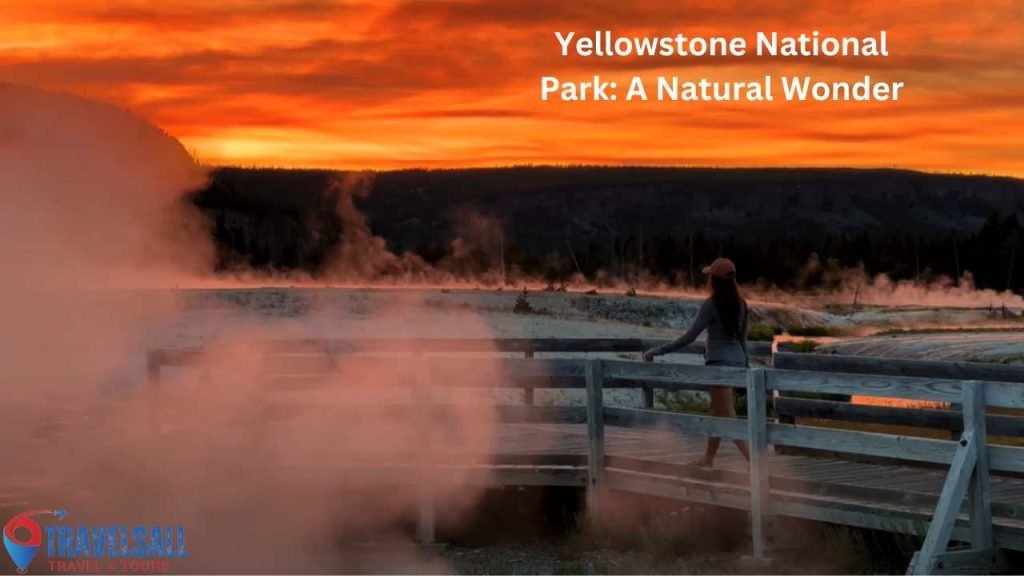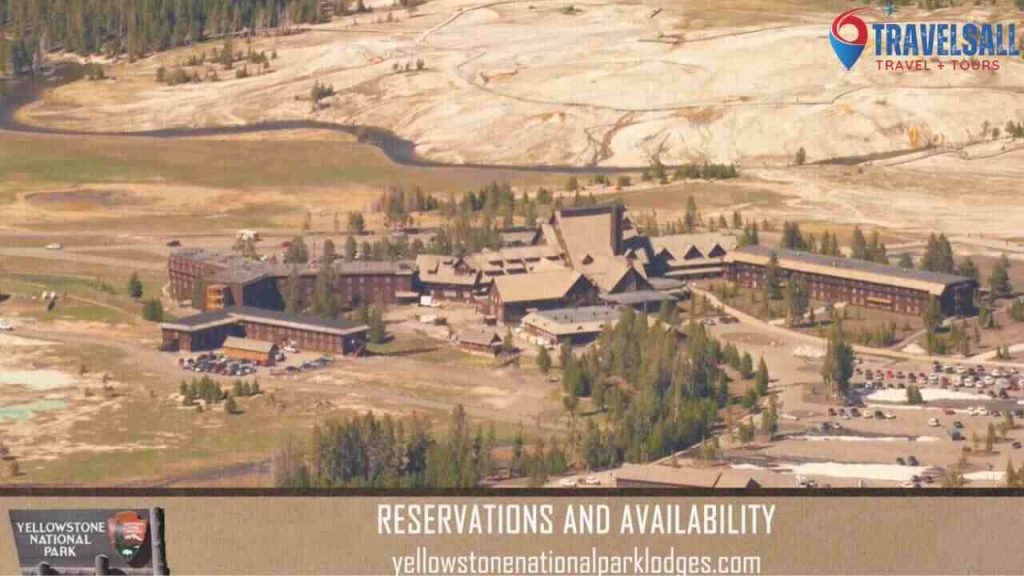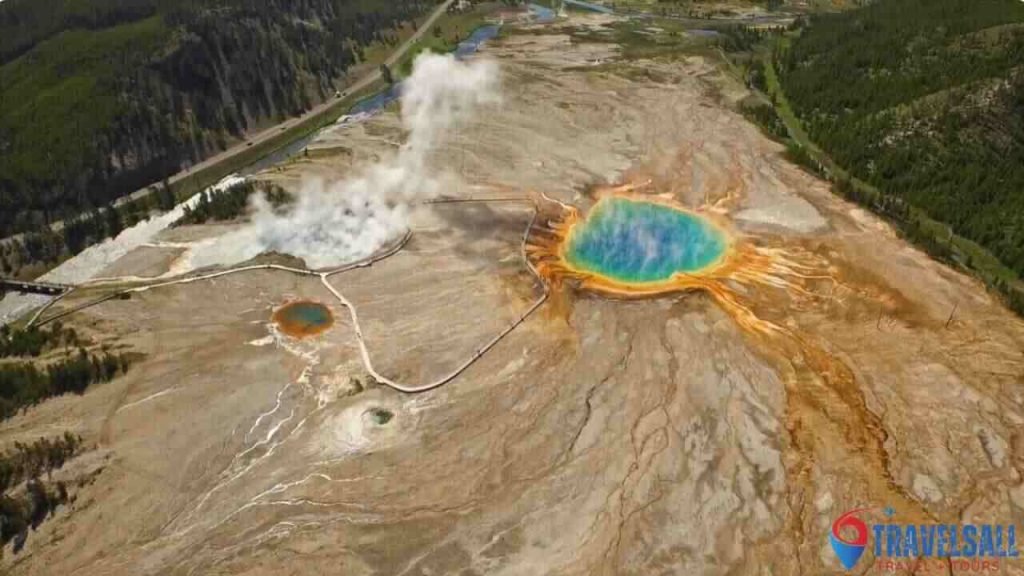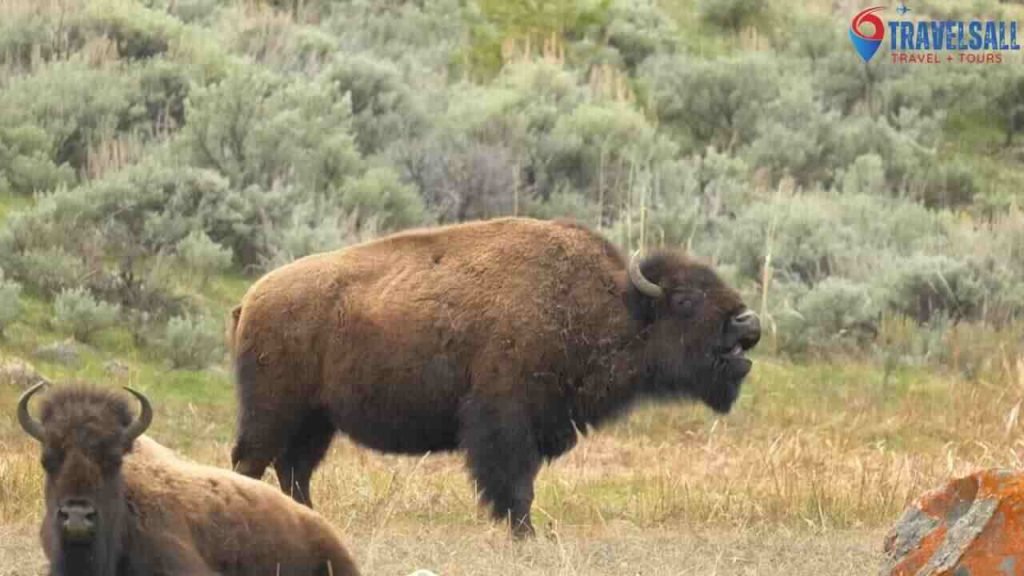The best way to see Yellowstone National Park is through a combination of driving and hiking. Guided tours can enhance the experience with expert knowledge.
Starting on an adventure to Yellowstone National Park, the first of its kind in the U. S. promises memorable sights and sounds.
Spanning over 2 million acres with geysers, hot springs, and an abundance of wildlife. Yellowstone captivates nature enthusiasts and casual visitors alike.
To truly enjoy the park’s wonders, a plan that balances scenic drives along its grand loop and exploring trails on foot is essential.
Choosing to engage with seasoned guides can uncover hidden gems and provide deeper insight into the park’s diverse ecosystem.
Year-round, Yellowstone’s vast landscapes demand respect and preparation, best enjoyed with an adventurous spirit.
Embrace the wild heart of Wyoming and Montana as you discover Yellowstone’s majestic beauty.
Table of Contents
ToggleYellowstone National Park: A Natural Wonder

In the heart of the United States lies a marvel that captures the essence of the wild. Yellowstone National Park is not just a park, but a vivid canvas where Mother Nature has painted her masterpiece.
This natural wonder, with its geothermal marvels, diverse wildlife, and stunning landscapes, beckons adventurers from around the world. Get ready to immerse yourself in the majesty of its iconic features.
The Majesty Of Geysers And Springs
Yellowstone’s ground boils with excitement, showcasing the park’s famous geothermal activity.
Visitors from every corner of the globe come to witness the erupting geysers and the shimmering hot springs that dot the park’s terrain.
- Old Faithful: A spectacle of punctuality and power, this geyser’s eruptions are a must-see.
- Grand Prismatic Spring: Marvel at the rainbow-colored waters, one of the park’s most photographed features.
A guided tour can help ensure you see the most impressive geysers and springs safely.
Exploring Diverse Ecosystems
With vast forests, rivers, and rolling hills, Yellowstone is home to some of the most varied ecosystems in North America.
| Ecosystem | Characteristics | Wildlife |
|---|---|---|
| Forests | Lush greenery and towering trees | Grizzly bears, wolves, lynx |
| Rivers | Clear waters and abundant fish | Otters, bald eagles, trout |
| Grasslands | Wide open spaces and wildflowers | Bison, elk, pronghorns |
Exploring these habitats, visitors can encounter wildlife in their natural domain and understand the delicate balance of this vast wilderness.
Planning Your Visit To Yellowstone
Yellowstone National Park is a marvel of natural beauty and geothermal wonders. It demands thoughtful planning to maximize your experience.
Key factors like when to visit and where to stay play a pivotal role in your adventure. Here’s how to plan your Yellowstone journey.
Choosing The Right Season
Each season in Yellowstone offers a unique experience. Summer brings
warm temperatures and the full availability of park services.
- Spring: Wildlife emerges, but weather can be unpredictable.
- Summer: Peak season, best for camping and hiking.
- Fall: Fewer crowds, stunning autumn colors.
- Winter: A snow-covered wonderland ideal for cross-country skiing.
Accommodations: Inside Vs. Outside The Park

Deciding on your accommodations greatly affects your park experience.
| Inside the Park | Outside the Park |
|---|---|
| Immersive nature experience | More accommodation options |
| Convenient for sightseeing | Often more budget-friendly |
| No daily commute | Broader dining choices |
| Book well in advance | Greater flexibility with plans |
Staying inside the park offers an intimate connection with nature
and easy access to trails.
Consider the convenience against the need for early bookings. Staying outside may be easier on the wallet with a broader range of options. Travel time to and from the park is the trade-off.
Navigating Through The Park
Exploring Yellowstone is an adventure like no other. Imagine winding roads with breathtaking views.
But knowing the best way to travel through the park is key. Let’s make sure your visit is both awe-inspiring and smooth.
Using Park Shuttles Vs. Personal Vehicles
Visitors have two main options for getting around Yellowstone: park shuttles or personal vehicles. Each has its pros and cons.
| Transport Mode | Pros | Cons |
|---|---|---|
| Park Shuttles | Eco-friendly No parking hassle The driver provides local insights | Set schedule and routes Possible wait times |
| Personal Vehicles | Flexible schedule Private space Explore off-beaten paths | Finding parking can be tough More carbon footprint |
Consider fuel efficiency and the size of your group when choosing. Shuttle services may limit personal footprints, ensuring a sustainable future for the park.
Popular Routes And Scenic Drives
Yellowstone brims with routes boasting majestic views. Each journey promises unforgettable sights.
- Grand Loop Road – Yellowstone’s main thoroughfare circles past the majority of the park’s must-see features.
- Lamar Valley Road – Spot wildlife in the ‘American Serengeti’ on an early morning drive.
- Firehole Canyon Drive – Marvel at waterfalls and hot springs on this one-way scenic loop.
Plan drives during off-peak hours for a less crowded experience. Remember, each season offers unique highlights and challenges.
Must-see Geothermal Features

Yellowstone National Park dazzles with its geothermal wonders.
Gushing geysers, bubbling mud pots, and hot springs decorate the landscape. A journey here is incomplete without witnessing these natural spectacles.
From Old Faithful’s timely eruptions to the vibrant colors of Grand Prismatic Spring, prepare for a visual feast. Here are the iconic spots to add to your Yellowstone adventure.
Old Faithful And The Upper Geyser Basin
Old Faithful, a symbol of nature’s punctuality, is the park’s star.
With eruptions every 44 to 125 minutes, visitors eagerly anticipate its performance. The Upper Geyser Basin, encompassing this famous geyser, boasts the largest concentration of geysers globally. A must-see area, it includes:
- Castle Geyser: Eruptions create castle-like formations.
- Riverside Geyser: Watch the water arc over the river.
- Beehive Geyser: Its spray reaches impressive heights.
Discover these and more on the boardwalks weaving through the basin.
The Grand Prismatic Spring Experience
The Grand Prismatic Spring is Yellowstone’s colorful treasure.
It’s the third-largest hot spring in the world. The vivid colors, from fiery orange to lush green, stem from microbial mats surrounding the mineral-rich water. The best vantage points include:
- Boardwalk View: Stroll around the spring’s perimeter for up-close hues.
- Overhead View: Hike the nearby trails for an elevated perspective.
Each angle offers a unique spectacle, making the Grand Prismatic a visual wonder of the park.
Wildlife Spotting Opportunities

Yellowstone National Park offers some of the most thrilling wildlife spotting opportunities in the world.
This vast and wild landscape is home to the iconic American bison, majestic elks, playful otters, and even stealthy wolves.
Visitors from all corners of the globe gather here with binoculars and cameras, hoping to catch a glimpse of these animals in their natural habitat.
Best Places For Wildlife Viewing
To maximize your chances of wildlife encounters, certain areas of the park are must-visits:
- Lamar Valley: Often called ‘America’s Serengeti.’ Catch herds of bison, packs of wolves, and more here.
- Hayden Valley: This lush valley is another hotspot for bison, and if you’re lucky, bears and wolves.
- Mammoth Hot Springs: Elk loves this area. You’re likely to see them grazing on the lawns.
For bird enthusiasts, Yellowstone Lake and the area around Fishing Bridge are excellent for spotting bald eagles and ospreys.
Early morning or later in the evening are prime times for wildlife viewing. Animals are more active during these cooler parts of the day.
Safety Tips When Encountering Animals
While observing wildlife, it is crucial to remember that these animals are wild and unpredictable.
- Maintain a safe distance. For most large animals, stay at least 100 yards away.
- If you encounter a bear or wolf, do not run. Slowly back away and avoid direct eye contact.
- Never feed the wildlife. Human food can harm animals and alter their natural behaviors.
Always carry bear spray if you’re hiking or walking in remote areas, and know how to use it before venturing out.
With these spots and safety tips in mind, your Yellowstone adventure is sure to be filled with incredible animal encounters. Safeguard yourself and the wildlife, and you’ll create memories that last a lifetime.
Hiking Trails For Every Skill Level
Yellowstone National Park offers an array of hiking trails to align with the varied abilities and interests of its visitors.
It doesn’t matter if you are just starting or a seasoned trekker; there are paths mapped out that are just right for you.
Family-friendly Walks
Kid-appropriate adventures await in Yellowstone’s vast wilderness. These walks are perfect for those traveling with children or preferring a more relaxed pace.
- Fairy Falls Trail: A gentle walk leading to a stunning waterfall.
- Trail of the Cedars: An easy loop through ancient trees.
- Riverside Trail: Meander alongside a river with ample wildlife viewing opportunities.
Adventures For The Experienced Hiker
For those seeking a challenge, Yellowstone’s rugged backcountry delivers. These trails are designed for experienced hikers in search of thrilling heights and breathtaking scenery.
- Mt. Washburn Trail: A demanding ascent with rewarding panoramic views.
- Electric Peak: Scale one of the park’s highest peaks.
- Black Canyon of the Yellowstone: An extended trek through diverse landscapes.
Guided Tours Vs. Self-guided Exploration
Majestic geysers, roaming wildlife, and stunning vistas define Yellowstone National Park. Decide between guided tours or crafting a solo adventure.
Both choices promise unique experiences. Your journey depends on preferences for education, flexibility, and independence. Let’s explore the benefits and drawbacks.
Pros And Cons Of Park Ranger Tours
Park ranger tours offer structured exploration with expert insights. These tours enhance understanding of the park’s history, geology, and ecology.
| Pros | Cons |
|---|---|
| Educational: Learn from rangers with deep knowledge. Included with Park Fee: No extra cost for most tours. Structured: Scheduled tours keep your day organized. | Crowds: Groups can be large and impersonal. Fixed Itinerary: Limited flexibility for personal interests. Time Constraints: Strict schedules may rush experiences. |
Creating Your Own Yellowstone Adventure
Prefer setting your own pace? Self-guided exploration meets that need. With a bit of planning, Yellowstone becomes your playground.
- Freedom: Choose what to see, when, and for how long.
- Spontaneity: Take side trails or linger at a stunning view.
- Privacy: Enjoy intimate moments with nature.
Prepare for a self-guided adventure. Study maps, check the weather, and know park regulations. Safety is key in the wild. Inform someone about your itinerary.
Capturing Memories: Photography In Yellowstone
Capturing Memories: Photography in Yellowstone stands as a timeless souvenir from this majestic landscape. Each click of the camera freezes a moment.
Pictures carry the power to transport you back. Yellowstone’s stunning scenery and wildlife offer endless photo opportunities.
Prepare for a visual journey through America’s first national park.
Scenic Spots For Photographers
Yellowstone teems with picturesque vistas. Every turn presents a new shot. Here’s where to aim your lens:
- Lower Falls: The Grand Canyon of Yellowstone frames this beauty.
- Grand Prismatic Spring: Want radiant colors? This spring never disappoints.
- Lamar Valley: Wide landscapes await, perfect for sunrise and sunset.
| Location | Feature | Best Time |
|---|---|---|
| Mammoth Hot Springs | Travertine terraces | Afternoon light |
| Old Faithful | Iconic geyser | Early morning or late afternoon |
| Yellowstone Lake | Reflective waters | Golden hour |
Ethical Wildlife Photography
Yellowstone’s wildlife is renowned. Approach photography with care and respect. Bear these tips in mind:
- Keep Distance: Use zoom lenses for close-ups. Stay safe and don’t disturb.
- Patience Pays: Animals won’t pose. Wait quietly for natural behavior.
- No Baiting: Feeding or luring wildlife for photos is dangerous and illegal.
Remember, your safety and animal welfare come first. Capture without consequences.
Preserving The Park For Future Generations
Yellowstone National Park is a treasure that belongs to everyone. We must ensure that its wonders remain intact for those who come after us.
By following sustainable practices and conservation ethics, we can all contribute to preserving this natural wonder.
Leave No Trace Principles
Embracing the Leave No Trace (LNT) principles is vital for protecting Yellowstone. Let’s break down these guidelines:
- Plan and prepare: Know the rules and what to expect.
- Travel and camp on durable surfaces: Stay on trails and official campsites.
- Dispose of waste properly: If you bring it in, take it out.
- Leave what you find: Natural objects and cultural artifacts stay put.
- Minimize campfire impacts: Use a camping stove and designated fire rings.
- Respect wildlife: Watch from a distance and do not feed animals.
- Be considerate of other visitors: Keep noise down and yield to others on trails.
Supporting Conservation Efforts
Active support for conservation initiatives further ensures the park’s vitality. Here’s how you can help:
- Join conservation groups or donate to them.
- Adopt eco-friendly practices, like using refillable water bottles.
- Take part in volunteer programs within the park.
- Educate others about the park’s ecosystem and heritage.
Your efforts, big or small, contribute to a sustainable Yellowstone.
Frequently Asked Questions Of Best Way To See Yellowstone National Park
How Many Days Do You Need To Visit Yellowstone National Park?
To fully experience Yellowstone National Park, plan for at least three to four days. This allows time to explore key attractions and hike a few trails.
What Is The Best Way To Tour Yellowstone?
The best way to tour Yellowstone is by car, allowing flexible exploration of the park’s numerous geysers, hot springs, and wildlife areas. Consider guided tours for expert insights and hiking trails for close encounters with natural features.
What Is The Best Month To Visit Yellowstone National Park?
The best month to visit Yellowstone National Park is September. Crowds thin, wildlife is active, and the weather is pleasant.
How Long Does It Take To Drive The Loop In Yellowstone?
Driving the entire loop in Yellowstone typically takes 4 to 7 hours, excluding stops for sightseeing and wildlife viewing. Traffic and road conditions can affect driving time.
Conclusion
Starting on a Yellowstone adventure promises unforgettable sights and experiences. Opt for tours, hikes, or a scenic drive to uncover its wonders.
Plan wisely, and respect nature, and Yellowstone will offer memories to cherish for a lifetime. Ready your itinerary and set forth into this majestic landmark’s embrace.



